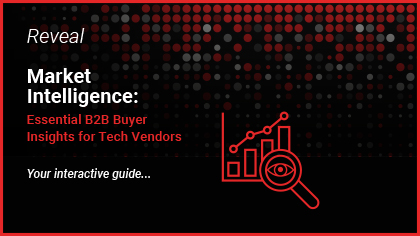In the ever-evolving landscape of B2B marketing, one concept has revolutionized the way businesses approach their sales and marketing strategies: intent-based marketing.
In fact it has become so commonplace, our first party data reveals that 99% of large B2B companies are leveraging buyer intent data in some capacity, with 70% planning to increase spending in the forthcoming year.
So why is intent-based marketing so popular?
Delving into the depths of customer behavior, this approach allows businesses to curate personalized experiences for their potential buyers – enhancing engagement and conversion rates.
Reading time:4 minutes
Read on as this comprehensive guide explores the full extent of intent-based marketing, its workings, and the multitude of benefits it offers…
The essence of intent-based marketing
Intent-based marketing leverages the digital footprints of customers, known as intent data, to curate customized and improved buying experiences. In order to do this, it relies solely on the concept of intent data.
Intent data encapsulates the information gathered from users’ interactions with various digital platforms. By analyzing this data, B2B marketers can gain invaluable insights into the preferences and requirements of their potential customers. This enables them to create personalized remarketing campaigns, inbound content and follow-up strategies.
Deciphering customer intent: Active vs passive
Customer intent can be broadly categorized into two types: active intent and passive intent.
- Active intent: Also known as transactional intent, active intent refers to a series of actions taken by prospective customers to gather specific details about a product or service. It indicates a strong willingness to buy, often leading to a swift closure.
- Passive intent: Termed as informational intent, passive intent has an educational focus. Prospects in this stage are still researching, signifying that they do not have an immediate need for a solution.
Harnessing intent-based marketing tactics
Employing intent-based marketing tactics allows modern marketers to tailor their budget towards the segmented target audiences that are most likely to make a purchase. Some common first party data points that help to give an indication of buyer intent include:
- Website visits
- Browsing habits
- Whitepaper downloads
- Product reviews
- Time on page
- Content consumption
- Scroll speed
- Topic request
Read on to find out why enriching these data points with third party intent that aggregates buyer signals from channels outside of your own, helps to scale your intelligence – giving you a much more accurate gauge of who’s in-market.
The multifaceted benefits of intent-based marketing
Adopting intent-based marketing strategies can yield a plethora of benefits, such as increased engagement and conversion rates, improved customer experience, and deeper insights into B2B buyer needs and preferences. According to a Statista survey, 90% of US consumers find personalized marketing content appealing to a certain degree. Here are some notable advantages of intent-based targeting:
Enhancement of ideal customer profiles
Ideal customer profiles (ICPs) are comprehensive descriptions of companies that would be a perfect match for a product. Insights from B2B buyer intent data can be matched to other parameters such as revenue, company size, background, geography, industry, and technology usage.
Boosting SEO
Search engine optimization (SEO) practices drive inbound traffic. By understanding which keywords, topics, and content styles are most requested by a target audience, B2B businesses can create the right types of content underpinning the most relevant content topics, to attract more organic visits.
Integration with account-based marketing
Account-based marketing (ABM), which focuses only on high-value accounts, aligns perfectly with intent-driven marketing. Marketers can leverage the power of B2B buyer intent data in ABM, to monitor surges in intent topics. This insight can be used to indicate if an account is moving in-market and inform accurate account prioritization. It can also be used to guide personalization strategies, ensuring the right messaging is delivered at the right time.
Leverage of programmatic advertising
Programmatic advertising platforms allow B2B marketers to place dynamic ads based on firmographic and behavioral intent. By precision targeting the most receptive audiences – at scale, across multiple channels with personalized ads, you can accelerate demand for your products/services and drive greater long term efficiencies.
Reduction in outbound marketing costs
By targeting audiences who have exhibited a clear buying intent, businesses can utilize their campaign budgets more efficiently. This, in turn, leads to a reduction in general marketing costs and an increase in return on investment (ROI).
Procuring intent data: First-party and third-party
In order to implement intent marketing, B2B businesses need to gather as many data points as possible. These can be categorized into first-party and third-party intent data.
First-party intent data
First-party intent data includes all of the information gathered directly from your owned channels. This data can be collected using website visitor tracking software that identifies even anonymous users and automatically scores leads based on their web activity.
Third-party intent data
Third-party intent data involves information collected across the web. This provides the opportunity to gather information from outside of you own channels, helping to provide a more in depth understanding of your target audience and where they are in their buyer journey.
Operationalizing intent-based targeting
The effectiveness of intent marketing campaigns vastly depends on the integration of inbound and outbound marketing efforts. The steps to develop a robust intent-targeting campaign include:
- Crafting a target account list (TAL): A target account list is a catalog of your qualified ICPs, handpicked by your marketing and sales teams. This document should detail every aspect of your ideal customer, guiding your team on which company to approach first, when, and through which channel.
- Selecting intent topics: Identifying the most relevant keywords, topics, and content strategy for your company is crucial for establishing brand awareness.
- Using intent-based marketing tools: Intent marketing relies heavily on the performance of intent data tools. These tools enable B2B marketing teams to match their TAL with the most relevant intent signals for their brand.
- Creating intent-based content: Customers’ online signals serve as guides for content creators. They can craft blog posts, whitepapers, product reviews, and other content pieces based on data-derived insights.
- Launching intent-based ads: Intent-based targeting can launch display, video, and audio ads to attract users who are actively searching for certain topics, keywords, and content pieces on other platforms.
The future of lead generation with intent-based marketing
As the B2B lead generation process becomes increasingly complex, it is essential to understand the online behavior of potential customers to generate more and better-qualified leads. By applying intent-based marketing tactics, businesses can be ready to provide prospects with the exact information and solutions they are looking for – enhancing their pipelines and facilitating more closed won deals.
Embrace intent-based marketing today and transform your business’s lead generation strategy for a more prosperous tomorrow…









